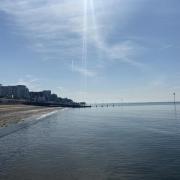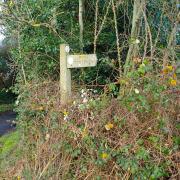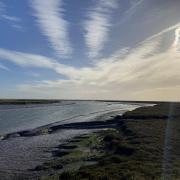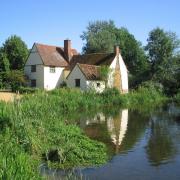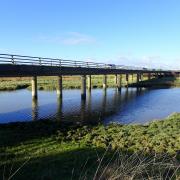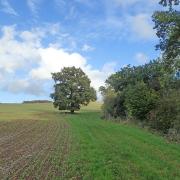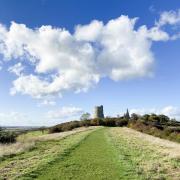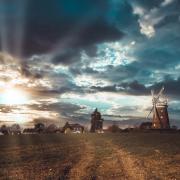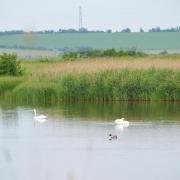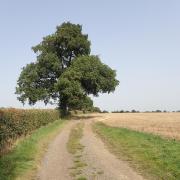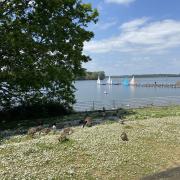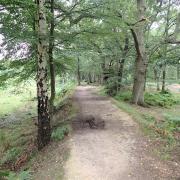On a crisp January day in Essex, there is nothing nicer than pulling on some wellies and getting outside for a brisk winter walk in our county’s wonderfully varied landscape. Nicky Adams and her whippet, Arthur, share five of the best locations to explore
Marks Hall Estate
Elegant landscaping, wild woodland and, very unusually, 200 eucalyptus trees, make Marks Hall a really striking place for a January stroll. This heritage landscape covers 2,350 acres of Essex countryside between Coggeshall and Earls Colne, all focused on a 200-acre arboretum of world-class importance, which brings together some of the most characteristic tree species from the temperate regions of the world, grouped together by geography.
Here you can walk in the January chill through atmospheric areas of woodland representing the landscapes of Europe, Asia, North America and the Southern Hemisphere, including Gondwanaland, the intriguing name for the ancient super continent that formed the evolutionary cradle for the vegetation of South America, the Indian subcontinents and Australasia – which is where you’ll find the eucalyptuses, as well as a collection of Nothofagus (or southern beech). There are many other exotic species to discover too.
Right in the middle of the arboretum, there’s The Wild Wood, a tree-covered half-acre that conceals lots of little details to spot, including mushrooms, fairy houses, faces and shapes, all made from offcuts and wood left over from conservation and management work on the estate, which will help entice little ones to keep walking. Den-building is encouraged and there are pine stepping stones and an oak seesaw to play on.
If your companions are four-legged they will appreciate the much longer woodland walks beyond the deer fence, some on a network of concrete runways that are a hangover from the estate’s war-time role as an airfield. There are three circular routes, all well-marked, and ranging from just half a mile to two-and-a-half miles, which start from the visitor centre. There is an admission charge, which goes towards the upkeep of the estate, which is run as a charity, but it’s well worth it for the chance to take such a global tour of nature, right on our doorstep.
Epping Forest
As you crick your neck to look up to the impossibly tall tree tops in the midst of Epping Forest, it’s quite easy to imagine our Stone Age ancestors doing just the same thing.
This densely wooded 5,900 acres of Essex, between the valleys of the rivers Lea and Roding, has been a forest for 12,000 years, and this history, combined with the gnarled ancient tree trunks with sprawling branches dusted with a layer of glistening frost, makes it a magical place for a walk.
It’s easy to get to too. It’s a short stroll from several railway stations and bus stops if you don’t have a car, but if you do, there are more than 50 free car parks nearby. In this vast landscape, it’s vital not to lose your bearings, so if you’re not familiar with Epping Forest’s layout of woodland, grassland, heath, rivers, bogs and ponds, then start at one of the forest’s four visitor centres to pick up a map of suggested trails.
Dogs and their owners are welcome to explore every one of the 50,000 ancient pollard trees, as well as over 100 lakes and ponds, many of which seem to appear out of nowhere in fairytale glades, but this is a Conservation Area of national and even international importance, so the creatures whose home it is can’t be disturbed. Dogs need to be kept under control and no more than four can be walked by one person at a time.
Any number of children are encouraged to visit, and all members of the family will enjoy wrapping up warm to explore Essex’s ancient, enchanted forest.

Hanningfield Reservoir
So many species of wildfowl take up residence at Hanningfield Reservoir in the winter months that the 870-acre body of water near Billericay, the 11th largest in England, is designated a Site of Special Scientific Interest.
The reservoir was formed in the 1950s when Sandon Valley was flooded, and most of the water and surrounding countryside were developed as a nature reserve and run by its owner, Essex and Suffolk Water, in conjunction with the Essex Wildlife Trust.
Every inch of the area is teeming with life and on a walk along one of the trails at the shore you could easily spot a gadwall, tufted duck or a pochard. At the southern end of the reservoir there are trails through 30 acres of ancient woodland, so it’s well worth picking up a guide from the Nature Discovery Centre to make sure you don’t miss any of the flora and fauna hiding in there.
With easy parking and a choice of two cafes, one with decking overlooking the water, this really is a tranquil spot for a January amble, surrounded by nature at every turn. Winter is a time to be outside and in touch with the elements and the sight of the water, great centuries-old trees and the creatures for whom it is a haven is nothing less than nourishment for the soul on a chilly Essex day.

Hadleigh Country Park
One of the largest open spaces in our county, covering 387 acres of undulating south Essex countryside, pastures, meadows and marshes, Hadleigh Country Park is a wonderful place for walking. That said, in 2012 it became famous around the world for a network of paths better suited to two wheels than two feet. The hilly terrain made Hadleigh the ideal mountain biking venue for the London Olympics and it has been a magnet for cyclists of all abilities ever since.
Whether you choose pedal-power, old-fashioned shoe leather or a combination of the two, Hadleigh Country Park is a great place to get some exercise. The elevation, unusual in our county, makes for some spectacular views of the Thames Estuary.
The best vantage point is from the atmospheric 13th century ruin of Hadleigh Castle, which stands just outside the boundaries of the park on a bluff overlooking the marshland of Leigh on Sea. Immortalised on canvas by John Constable, this makes a distinctive destination for a walk – in fact, there’s a 9km trail leading to it.
A great place to end your stroll is the Salvation Army’s Hadleigh Farm tearoom, which serves warming drinks and snacks to restore your energy. There’s also the Hub Building, which has a café and a bike shop with cycles to hire.
But it’s not just feet and wheels that can take you down a slope speedily – any hill takes on new importance if the weather turns to snow and Hadleigh Country Park is a perfect paradise for sledgers.

Mersea Island
Who can spot a red squirrel? If you’re walking on Mersea Island you have more of a chance of seeing a flame-tailed little critter than anyone anywhere else in the country. Despite being an endangered species, they are thriving on the UK’s most easterly inhabited island, thanks to a successful reintroduction programme a few years ago.
East Mersea is the place to stroll if squirrels are your thing. At Cudmore Grove Country Park there’s a circular walk that takes in 102 acres of open grassland and the sandy beach by the oyster fishery. In winter, you can often see flocks of Brent geese, as well as many species of wading birds on the mudflats, and birds of prey.
On the other side of the island, colourful beach huts line the pebbly shore of West Mersea and brighten up any dull January day. Dogs are welcome on the beach all year round and, if yours is of the particularly energetic variety, or your legs are in need of a good stretch, you could set out to walk the circumference of the island, which is seven square miles in size.
The views across the estuary often feature sailing boats and hardy stand-up paddleboarders in winter wetsuits, making a walking challenge well worthwhile. Mersea has a lively community of artists and photographers who are drawn to the extraordinary island light, which creates some spectacular reflections on the water, as well as sunrises and sunsets that are Instagrammable. There can be no better place than Mersea Island to blow away the cobwebs, but don’t forget your woolly hat!

________________
Follow Essex Life on Facebook, Twitter and Instagram
________________




